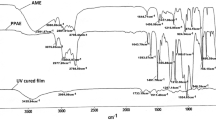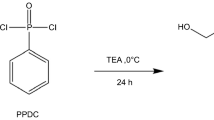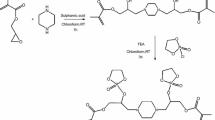Abstract
Multifunctional phosphorus and nitrogen containing tris-diethanolamine spirocyclic pentaerythritol bisphosphorate reactive diluent (TDSPBRD) for epoxy acrylate oligomer was synthesized from spirocyclic pentaerythritol bisphosphorate diphosphoryl chloride, diethanolamine, and allyl chloroformate. The synthesized reactive diluent was utilized to formulate ultraviolet (UV)-curable wood coating. The weight fraction of reactive diluent in the coating formulation was varied from 5 to 25 wt% with constant photoinitiator concentration. The molecular structure of the reactive flame retardant was confirmed by Fourier transform infrared (FTIR), 1H nuclear magnetic resonance (NMR) and 31P NMR spectral analysis and energy dispersive spectroscopy (EDAX). Further, the effectiveness of the flame retardant behavior of the coatings was evaluated using the limiting oxygen index and UL-94 vertical burning test. Thermal stability was estimated from thermogravimetric analysis and differential scanning calorimetry. The effects of varying the concentration of TDSPBRD on the viscosity of the coating formulation along with the optical, mechanical and chemical resistance properties of the coatings were evaluated. The coatings gel content, water absorption behavior, and stain resistance were also studied.














Similar content being viewed by others
References
Laoutid, F, Bonnaud, L, Alexandre, M, Lopez-Cuesta, JM, Dubois, PH, “New Prospects in Flame Retardant Polymer Materials: From Fundamentals to Nanocomposites.” Mater. Sci. Eng. R, 63 100–125 (2009)
Liang, S, Matthias Neisius, N, Gaan, S, “Recent Developments in Flame Retardant Polymeric Coatings.” Prog. Org. Coat., 76 1642–1665 (2013)
Yew, MC, Ramli Sulong, NH, Yew, MK, Amalina, MA, Johan, MR, “Influences of Flame-Retardant Fillers on Fire Protection and Mechanical Properties of Intumescent Coatings.” Prog. Org. Coat., 78 495–501 (2014)
Derouet, D, Morvan, F, Bross, JC, “Chemical Modification of Epoxy Resins by Dialkyl (or Aryl) Phosphates: Evaluation of Fire Behavior and Thermal Stability.” J. Appl. Polym. Sci., 62 1855–1868 (1996)
Camino, G, Costa, L, Martinasso, G, “Intumescent Fire-Retardant Systems.” Polym. Degrad. Stab., 23 359–376 (1989)
Liu, R, Wang, X, “Synthesis, Characterization, Thermal Properties and Flame Retardancy of a Novel Nonflammable Phosphazene-Based Epoxy Resin.” Polym. Degrad. Stab., 94 617–624 (2009)
Liu, YL, “Epoxy Resins from Novel Monomers with a Bis‐(9, 10‐Dihydro‐9‐Oxa‐10‐Oxide‐10‐Phosphaphenanthrene‐10‐yl‐) Substituent.” J. Polym. Sci., 40 359–368 (2002)
Martin, C, Ronda, JC, Cadiz, V, “Boron-Containing Novolac Resins as Flame Retardant Materials.” Polym. Degrad. Stab., 91 747–754 (2006)
Liang, H, Asif, A, Shi, W, “Thermal Degradation and Flame Retardancy of a Novel Methacrylated Phenolic Melamine Used for UV Curable Flame Retardant Coatings.” Polym. Degrad. Stab., 87 495–501 (2005)
Xing, W, Jie, G, Song, L, Hu, S, Lv, X, Wang, X, Hu, Y, “Flame Retardancy and Thermal Degradation of Cotton Textiles Based on UV-Curable Flame Retardant Coatings.” Thermochim. Acta, 513 75–82 (2011)
Cheng, X, Liu, S, Shi, W, “Synthesis and Properties of Silsesquioxane-Based Hybrid Urethane Acrylate Applied to UV-Curable Flame-Retardant Coatings.” Prog. Org. Coat., 65 1–9 (2009)
Cheng, X, Shi, W, “UV-Curing Behavior and Properties of Tri/Di (Acryloyloxyethyloxy) Phenyl Silane Used for Flame-Retardant Coatings.” Prog. Org. Coat., 69 252–259 (2010)
Tathe, D, Jagtap, RN, “Biobased Reactive Diluent for UV-Curable Urethane Acrylate Oligomers for Wood Coating.” J. Coat. Technol. Res., (2015). doi:10.1007/s11998-014-9616-5
Chen, X, Hu, Y, Jiao, C, Song, L, “Thermal and UV-Curing Behavior of Phosphate Diacrylate Used for Flame Retardant Coatings.” Prog. Org. Coat., 59 318–323 (2007)
Chen, X, Hu, Y, Jiao, C, Song, L, “Preparation and Thermal Properties of a Novel Flame-Retardant Coating.” Polym. Degrad. Stab., 92 1141–1150 (2007)
Jirasutsakul, I, Paosawatyanyongb, B, Bhanthumnavind, W, “Aromatic Phosphorodiamidate Curing Agent for Epoxy Resin Coating with Flame-Retarding Properties.” Prog. Org. Coat., 76 1738–1746 (2013)
Ma, H, Fang, Z, “Synthesis and Carbonization Chemistry of a Phosphorous-Nitrogen Based Intumescent Flame Retardant.” Thermochim. Acta, 543 130–136 (2012)
Wang, G, Huanga, Y, Hua, X, “Synthesis of a Novel Phosphorus-Containing Polymer and Its Application in Amino Intumescent Fire Resistant Coating.” Prog. Org. Coat, 76 188–193 (2013)
Liu, YL, Hsiue, GH, Chiu, YS, ”Synthesis, Characterization, Thermal and Flame Retardant Properties of Phosphate-Based Epoxy Resins.” J. Polym. Sci. A: Polym. Chem., 35 565–574 (1997)
Mercado, LA, Reina, JA, Galia, M, “Flame Retardant Epoxy Resins Based on Diglycidyloxymethylphenylsilane.” J. Polym. Sci., 44 5580–5587 (2006)
Moreno, M, Lligadas, G, Ronda, JC, Galia, M, Cadiz, V, “Flame Retardant High Oleic Sunflower Oil-Based Thermosetting Resins Through Aza- and Phospha-Michael Additions.” J. Polym. Sci., 51 1808–1815 (2003)
Alcon, MJ, Ribera, G, Galia, M, Cadiz, V, “Advanced Flame-Retardant Epoxy Resins from Phosphorus-Containing Diol.” J. Polym. Sci., 43 3510–3515 (2005)
Dasari, A, Yu, ZZ, Cai, G-P, Mai, Y-W, “Recent Developments in the Fire Retardancy of Polymeric Materials.” Prog. Polym. Sci., 38 1357–1387 (2013)
Xu, MJ, Ma, Y, Hou, M-J, Li, B, “Synthesis of Crosslinked Triazine Phosphine Polymer and Its Effect on the Fire Retardancy, Thermal Degradation and Moisture Resistance of Epoxy Resins.” Polym. Degrad. Stab., 119 14–22 (2015)
Liu, YL, “Flame-Retardant Epoxy Resins from Novel Phosphorus-Containing Novolac.” Polymer, 42 3445–3454 (2001)
Liyang, H, Shi, W, “Thermal Behaviour and Degradation Mechanism of Phosphate Di/Triacrylate used for UV Curable Flame-Retardant Coatings.” Polym. Degrad. Stab., 84 525–532 (2004)
Chen, X, Jiao, C, “Thermal Degradation Characteristics of a Novel Flame Retardant Coating using TG-IR Technique.” Polym. Degrad. Stab., 93 2222–2225 (2008)
Ang, DT, Gan, SN, “Novel Approach to Convert Non-self Drying Palm Stearin Alkyds into Environmental Friendly UV Curable Resins.” Prog. Org. Coat., 73 408–414 (2012)
Author information
Authors and Affiliations
Corresponding author
Rights and permissions
About this article
Cite this article
Chambhare, S.U., Lokhande, G.P. & Jagtap, R.N. UV-curable behavior of phosphorus- and nitrogen-based reactive diluent for epoxy acrylate oligomer used for flame-retardant wood coating. J Coat Technol Res 13, 703–714 (2016). https://doi.org/10.1007/s11998-015-9777-x
Published:
Issue Date:
DOI: https://doi.org/10.1007/s11998-015-9777-x




